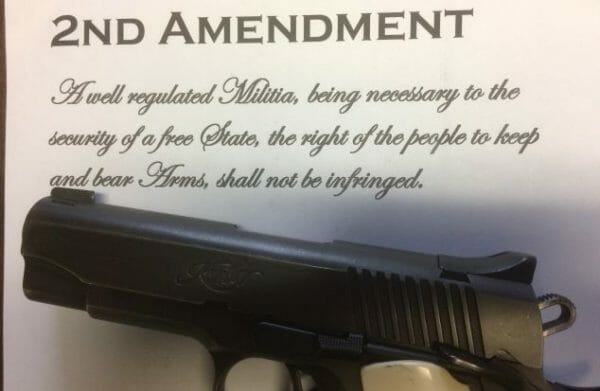
New Jersey – -(AmmoLand.com)- Quite possibly in ten years I’ll grow tired of reading learned analysis and breakdowns of NYSRPA v. Bruen. As I explained to my wife when we were driving in the car on November 3, 2021, going from Garden to Bay State, and I insisted on listening to the live feed of the arguments, “This is my Super Bowl.” I’ve spent a lifetime listening to people talk about sportsball, as if that’s important, up to and including guests leaving my home from a gathering early so they were home in time for the “Pats”, it’s my time now.
One analysis of the NYSRPA v. Buren opinion came across my bow and it’s worth a gander. Theresa Inacker, who readers may know from the feature I did on the DC Project in NJ here, or last month’s coverage of her missing testimony in Trenton at Bearing Arms, wrote a great piece over at SCOTUS Blog. Trenton may not want to know what Inacker has to say, but the reporting wing of the Supreme Court of the United States does.
Her piece, “From constitutional orphan to treasured heirloom: The Second Amendment is no longer a second-class right”, focuses on how the Second Amendment plays a pivotal role in the lives of marginalized people. On June 23, 2022 the adoption papers came in, and now the Second Amendment is no longer a disenfranchised second class right.
While the Second Amendment itself has been the marginalized “constitutional orphan,” the outlier states’ oppressive carry bans likewise impacted marginalized groups. The DC Project Foundation (along with organizations representing LGBTQ and Jewish gun owners) filed an amicus brief to highlight the perspectives of these marginalized groups, whose members wish to carry a firearm outside the home for the lawful purpose of self-defense. Women, religious minorities, and members of the LGBTQ community often find themselves disproportionately victims of violent crime. In his concurrence, Justice Samuel Alito referenced these concerns, nothing that “[s]ome briefs were filed by members of groups whose members feel that they have special reasons to fear attacks.”
As The DC Project Foundation argued in its brief, “The threat of violence women face when they go out in public is very real and quite substantial. No amount of gun control legislation can change that. … Indeed, the ability to carry a firearm is a vital means for women to protect themselves from violent male assailants.” And “[w]omen are especially vulnerable to violent attacks from men because of typical size and strength disparities. Over a third of women in the U.S. have ‘experienced contact sexual violence, physical violence, and/or stalking by an intimate partner during their lifetime.’”
Women are the largest growing segment of new gun owners over the past few years. The outlier states have hampered the ability of women to defend themselves in public. In recounting the extensive history in Bruen, Thomas recognized how state impediments to the exercise of this fundamental right by disenfranchised groups is also part of postbellum history: “After the Civil War, of course, the exercise of this fundamental right by freed slaves was systematically thwarted. This Court has already recounted some of the Southern abuses violating blacks’ right to keep and bear arms.”
I can sit here and say the same thing over and over again, but for some reason, it sounds so much better coming from one of the DC Project’s own teal clad superheroes. The friend of the court brief filed by the DC Project, Pink Pistols, Operation Blazing Sword, and Jews for the Preservation of Firearms Ownership, dives into the history of marginalized people in society, as does Inacker here. Inacker further pointed out where infringements were historically par for course in post reparation America. The brief cited recounted acts of violence against said persons in modern times. It’s hard to ignore the facts. Inacker is correct in pointing out the equalization properties of arms, and how violence against women, et.al. can be thwarted via the use of a defensive firearm.
Thomas makes clear that the text, history, and tradition test is to be applied to Second Amendment challenges going forward. Interest-balancing tests are out. A brightline test for subsequent Second Amendment cases is here: Lower courts must apply the “text, as informed by history” and reject any analysis via tiered scrutiny.
So, what does this mean for existing laws, and even future gun control? What does this mean for magazine capacity limits? Age limits? The right to self-manufacture firearms? Courts will soon analyze these and other measures under the Second Amendment’s text, as informed by history.
So succinctly summed up, the new goal post infringers have to meet, was pointed out. I’m not going to put words in Inacker’s mouth, but I’m willing to wager she’d agree with me if I said the “text, history, and tradition” test is going to be the headshot to the anti-gun movement. Her postulations on where NYSRPA v. Bruen will take us seem to be foreshadowed in her queries. Further than this analysis of how everything’s going to flesh out, I’m, like many of Inacker’s other faithful readers I’m sure, can’t wait to see how she carves up the first few post NYSRPA v. Bruen decisions.
About John Petrolino
John Petrolino is a US Merchant Marine Officer, writer, author of Decoding Firearms: An Easy to Read Guide on General Gun Safety & Use and NRA certified pistol, rifle, and shotgun instructor living under and working to change New Jersey’s draconian and unconstitutional gun laws. You can find him on the web at www.johnpetrolino.com on twitter at @johnpetrolino, facebook at @thepenpatriot and on instagram @jpetrolinoiii .

from https://ift.tt/AP9F4Sv
via IFTTT

No comments:
Post a Comment